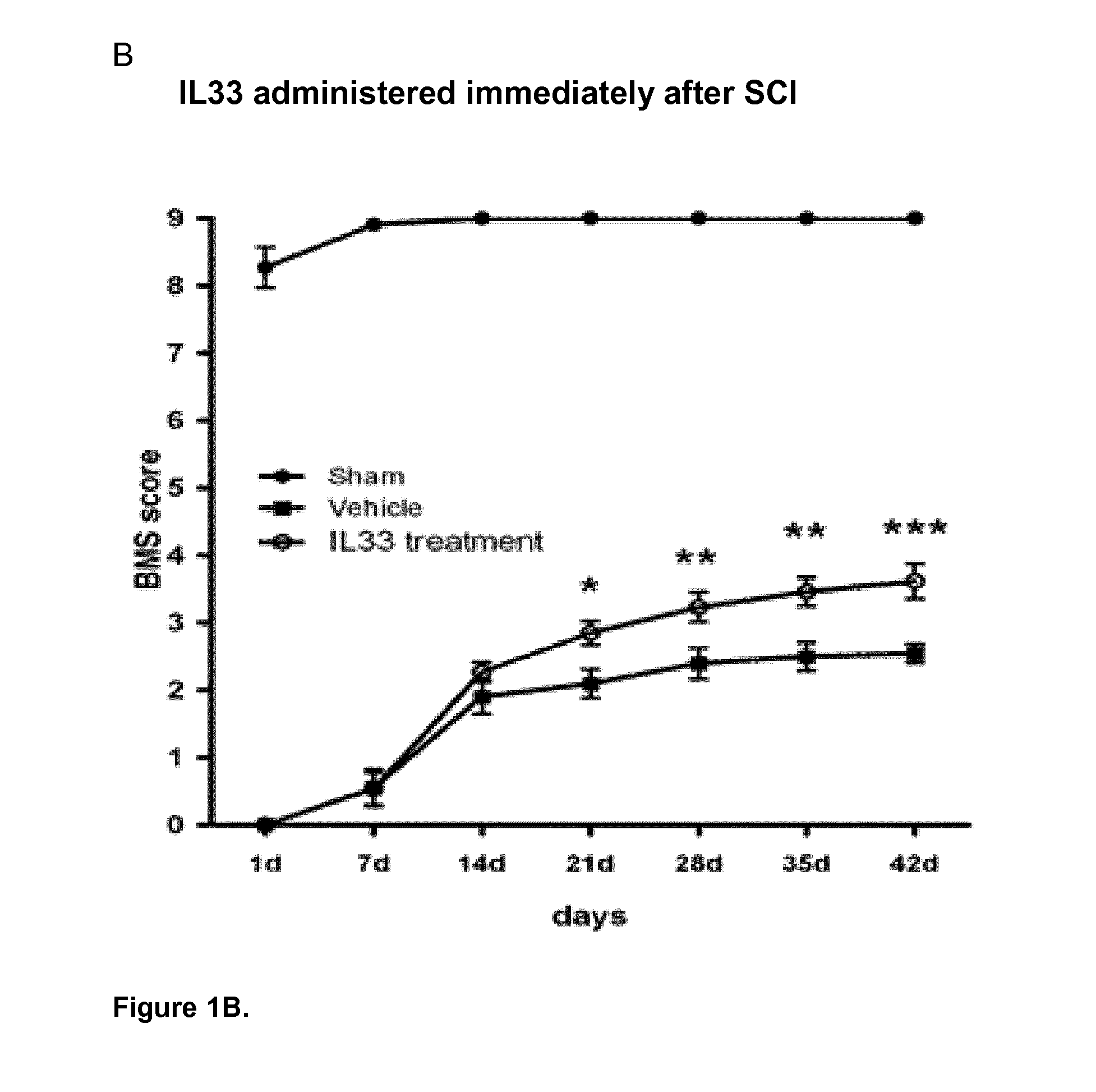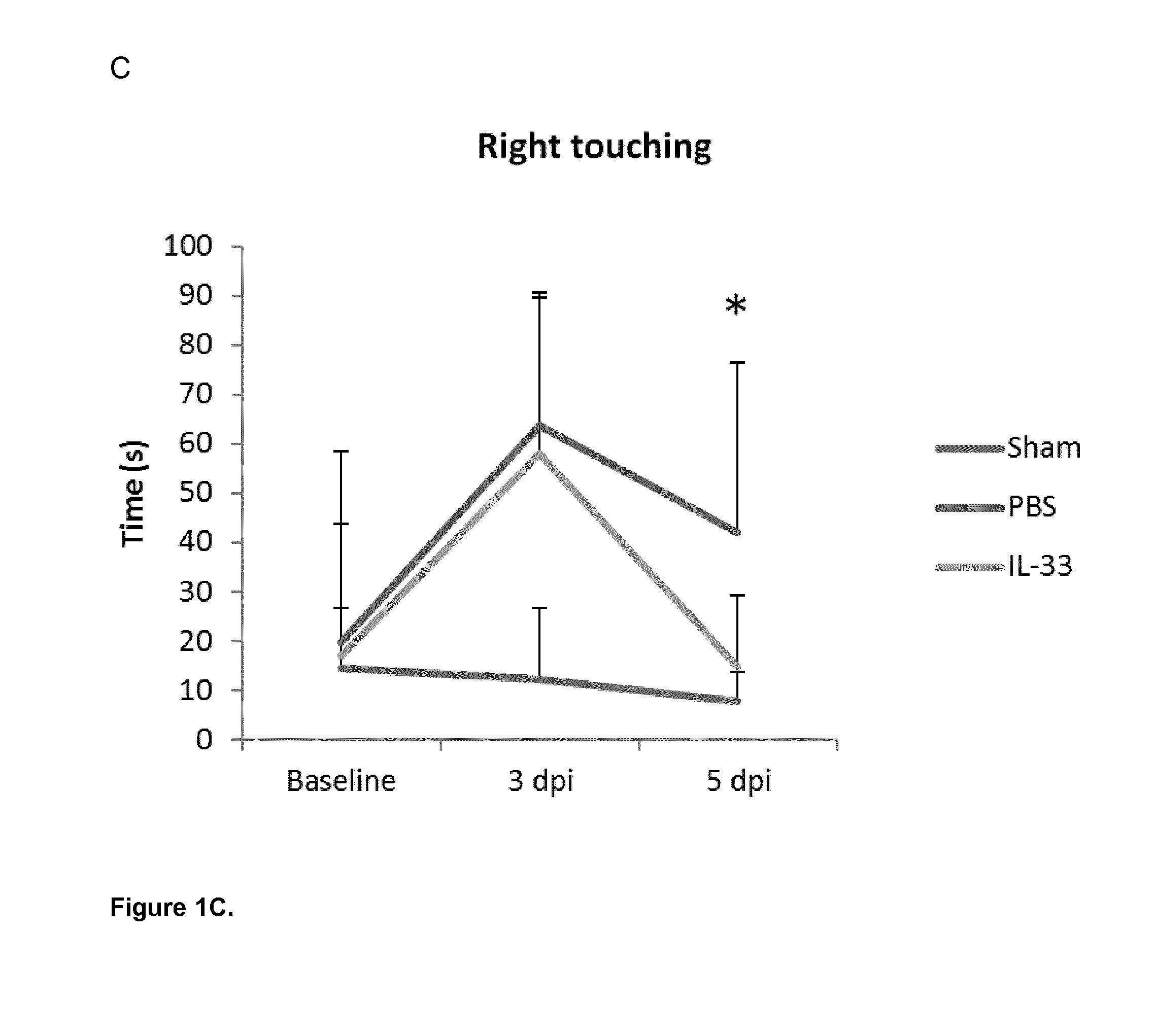IL-33 and Treatment of Neurodegenerative Diseases
- Summary
- Abstract
- Description
- Claims
- Application Information
AI Technical Summary
Benefits of technology
Problems solved by technology
Method used
Image
Examples
example 1
SCI Model
[0112]Contusion injury at the T10 level in spinal cord is the most representative model of human clinical SCI. This injury model produces spinal cord neuronal damage and consequent motor deficits, the magnitude of which is dependent on the impact of the injury. The size of the lesion and magnitude of the motor deficits are highly reproducible and constant.
[0113]Mice undergoing SCI were given four consecutive dosages of IL-33 (Biolegend, SanDiego, Calif., USA), within 2 weeks, starting either prior to the onset of injury or after the induction of injury.
[0114]IL-33 treatment ameliorated SCI induced motor deficits in C57BL / 6j mice when given both pre- and post-injury. Importantly, the improvement in Basso Mouse Scale (BMS) (Basso et al., 2006) was greater when the treatment was started after injury, making this study highly clinically relevant. (Figures 1A and B) Indeed, IL-33 treatment results in long functional improvement following chronic CNS condition. IL-33 treatment im...
example 2
ALS Model
[0116]Identification of genetic deficits responsible for ALS has enabled the creation of precise genetic models of ALS. The G93A-SOD1 mouse strain is the most widely used model in ALS research, which leaves the enzyme activity intact. Due to the ready availability of the G93A mouse, many studies of potential drug targets and toxicity mechanisms have already been carried out in this model, and was utilized here.
[0117]Mice received recombinant mouse IL-33 (Biolegend, SanDiego, Calif., USA) twice per week with PBS vehicle controls. The treatment was started pre-symptomatically at the age of 80 days and continued until the age of 20 weeks. The mice were sacrificed at the age of 22 weeks.
[0118]IL-33 treatment significantly delayed disease onset (FIG. 6A) compared to controls. To investigate whether IL-33 treatment had a beneficial effect on the T-cell profile in ALS, the lymphocyte populations in lymph nodes were analysed. IL-33 treatment reduced the proportion of CD4+ T-cells i...
example 3
MCAo Model
[0119]Permanent MCA occlusion is one of the most widely used preclinical models of brain ischemia and was also utilized here. Focal pMCAo models a clinical condition in which an embolus or blood clot prevents the cerebral blood flow in a restricted brain area and the lesion is produced without re-flow. This represents a human clinical stroke in situations when the patient is not suitable for thrombolysis therapy and, due to the very limited number of patients (only 5%) suitable for tPA treatment, this model has high clinical relevance.
[0120]The mice undergoing pMCAo received i.p injections of IL-33 (Biolegend, SanDiego, Calif., USA) starting either prior to ischemia or after the induction of ischemia. The mice undergoing pMCAo received i.v injections of IL-33 (Biolegend, SanDiego, Calif., USA) starting either prior to ischemia or after the induction of ischemia. The neuronal death was determined by MRI imaging at 24 hours post ischemia.
[0121]Quantification of the lesion si...
PUM
| Property | Measurement | Unit |
|---|---|---|
| Fraction | aaaaa | aaaaa |
| Fraction | aaaaa | aaaaa |
Abstract
Description
Claims
Application Information
 Login to View More
Login to View More - R&D
- Intellectual Property
- Life Sciences
- Materials
- Tech Scout
- Unparalleled Data Quality
- Higher Quality Content
- 60% Fewer Hallucinations
Browse by: Latest US Patents, China's latest patents, Technical Efficacy Thesaurus, Application Domain, Technology Topic, Popular Technical Reports.
© 2025 PatSnap. All rights reserved.Legal|Privacy policy|Modern Slavery Act Transparency Statement|Sitemap|About US| Contact US: help@patsnap.com



